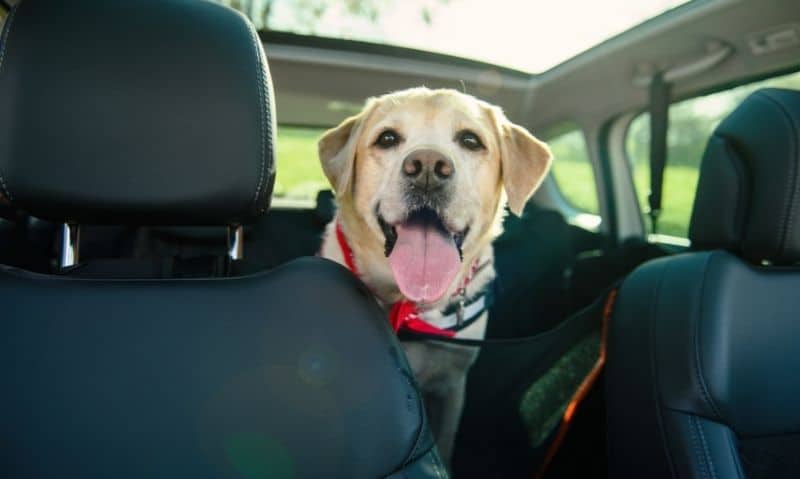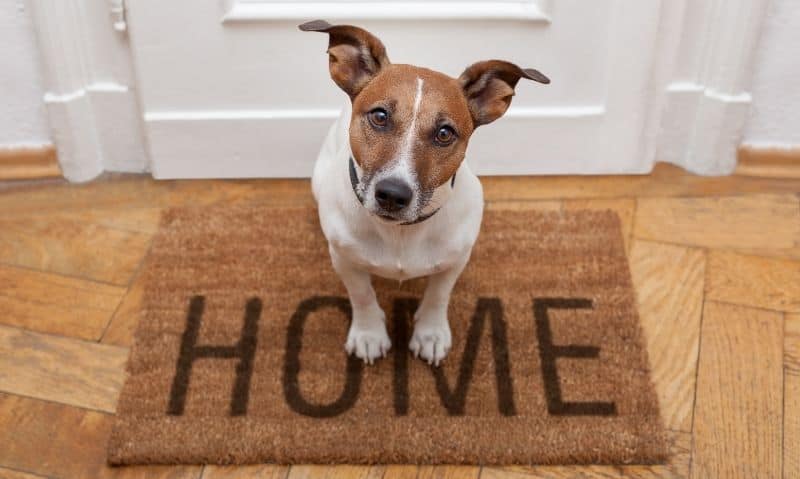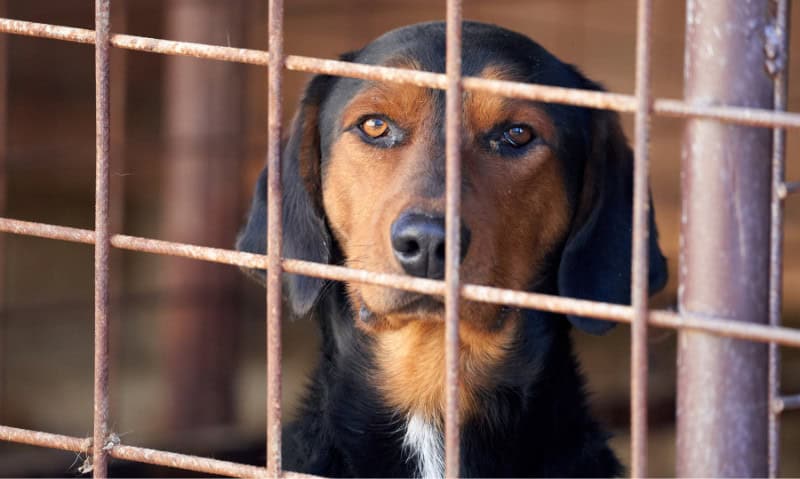What to Expect on Your First Night with a Rescue Dog
Preparing to bring your new pup home is a busy time. You’re likely excited to start bonding with your new companion, building the kind of friendship that can only be shared between dog and owner.
However, your first night with a rescue dog can also be a stressful and overwhelming time, especially for first-time dog owners.
Let’s look at what you can expect that first night and how you can make this experience as smooth and enjoyable as possible!
Disclosure: This post may contain affiliate links, meaning I will earn a commission if you purchase through my links, at no cost to you. For more info, Please read my full Disclosure.
As excited as you are to bring your new rescue dog home, it’s important to remember that this can be an incredibly stressful experience for your new pup.
Everything that he has known up until this point is now changing as he moves into a new house with a new family.
This kind of change and adjustment is going to take time.
Often, a new dog will shut down or retreat in the first few days that they are in their new home.
This is a response to feeling overwhelmed as they learn how to navigate their new space, schedule, family, and rules.
The following tips will help you set your pup up for success, but they don’t mean that you won’t encounter any bumps in the road.
As you get ready for your first day with the new pup, make sure that you are setting reasonable expectations for the early days.
Your dog will be learning the rules in their new home, but he isn’t familiar with them yet.
What Do I Need to Know for a Safe Car Ride Home?
Before even worrying about how your dog is settling in at home, you need to make sure that you can bring him home safely and without innocent.
There are a few different factors to consider when it comes to the first car ride home.
When you come to pick up your new pup, make sure to bring a collar or harness (or both), a leash, and an ID tag with your contact information.
If your dog does get loose, he is going to be lost and scared in an area that he doesn’t recognize.
While you can’t guarantee that there is no chance that he will get away, you can take every step possible to minimize the chance of a problem.
GoTags Paw Print Round Stainless Steel Pet Tag for Dogs and Cats
These stainless steel dog tags are the perfect solution for ensuring your pet is never without reliable identification. On the front, a glittery paw print in your choice of colours adds a fun and stylish touch while the back can be customized with up to 4 lines of text.
Dogs that are a known flight risk should always be attached to two separate leashes during the trip, either to two different collars or to a collar and a harness.
This will ensure that your dog can’t bolt if one leash or collar fails.
While in your vehicle and travelling, make sure that your dog is secured safely.
One option of securing your dog for travel is through using a dog crate.
If your dog is a smaller dog or puppy, this crate should be held in place using a seatbelt to prevent it from flying around the vehicle.
Sleepypod Air – Airline Approved Pet Carrier and Crash-Tested Car Seat for Cats and Dogs
Suitable for cats and small dogs up to 18lbs, this soft-sided pet carrier is both airline compliant and certified crash-tested by the Center for Pet Safety. It features an easy-to-clean, machine washable, and removable water-repellent liner and large zippered pockets for all your pet’s gear.
Another popular often is the use of a pet seatbelt.
These are products that are designed to secure your dog to the seatbelt of the vehicle, preventing him from being thrown from the vehicle in the event of an accident.
This should be used with a crash-tested dog harness and never with just a collar.

What Should I Do First When We Get Home?
It may be tempting to immediately bring your new dog into the living room and huddle around him as a family, but you need to start slow.
The first thing that you should do upon arriving at home is bring your dog immediately to the designated bathroom spot in your yard (or a pee pad indoors if that’s what you plan on using).
There is a good chance that your dog will need to go to the bathroom with the combination of high excitement and the car ride.
When he does, be sure to praise him. This will help to establish a baseline for housebreaking.
After you have given your dog a chance to go to the bathroom and calm down from the trip, bring him into his ‘safe space’ in the house.
This is an area of the home that has been fully puppy-proofed to prevent any accidents.
By limiting how much space he has access to, you are giving him a chance to adjust and acclimate without overwhelming him.
Hold off on any major introductions in the beginning until your dog has had a chance to settle into his home environment.
This includes both introductions with children and other animals that live in your home.
Make food and fresh water accessible to your dog, but don’t stress if he is showing no interest in eating.
Often dogs will skip meals when they are feeling anxious and stressed out.
It is not uncommon for a new dog to refuse food for one or two days after moving to his new home.
How Long Will It Take My Rescue Dog to Settle?
There is no easy timeline that you can follow when it comes to helping your dog adjust to his new surroundings as every dog is different.
However, many in the rescue world (myself included) will recommend that you follow the 3-3-3 rule as a guideline.
The 3-3-3 Rule states that:
It will take approximately 3 days for your new dog to decompress and stop feeling scared, anxious, and unsure in his new home.
It will take approximately 3 weeks for your new dog to learn your schedule and routine and start to reveal his true personality (including any quirks and bad habits).
It will take approximately 3 months for your new dog to feel fully comfortable and at home.
The length of time that it takes your dog to adjust will depend on several different factors.
This includes his past experiences, his age (puppies tend to adjust quicker than older dogs that have had more experiences in life), and the home atmosphere that you have created for him.

When Should I Introduce My Dog to Children and Other Pets?
If you should avoid introductions on the first night with a rescue dog, when should you make these introductions happen?
There is no firm timeline that you need to follow.
Instead, allow your dog to determine when the time is right to start introducing more into his already changing environment.
When you notice that your dog is starting to feel calmer and more comfortable, you can start slowly introducing the rest of the family.
Keep your introductions short in the beginning to avoid overwhelming or stressing your pup, limiting it to one child or pet at a time.
During this time, your dog should be on a leash, allowing you to quickly regain control if necessary.
Avoid including treats or toys, focusing instead on allowing your dog to adjust to their new family member.
OutdoorMaster Heavy Duty Bungee Dog Leash with Shock Absorption
This sturdy bungee-style dog leash features two strong elastic ropes for added strength and security. The heavy duty clasp is rated to handle up to 1000 lbs, making it a suitable options for dogs of all sizes. Two padded handles ensure you will have control over your dog in any setting.
Teach your child(ren) to move slowly and calmly when they are around the new dog to avoid spooking him.
Have your child(ren) approach the new pup from the side and stop a short distance away, giving your dog the opportunity to willingly close the distance and initiate the meeting on his own terms.
This same approach can be used when introducing pets to one another, allowing for some time at a short distance adjusting to the smell and presence of their new ‘pack member’.
After a short time, remove your new dog from the situation and give him a break.
It won’t happen overnight but taking the time to do introductions properly will set you up for a well-adjusted family in the long run.
Where Should My Rescue Dog Sleep?
One of the biggest questions that many new dog owners have when considering their first night with a rescue dog is where their new dog should sleep.
There are many different answers to this, however, here on Shed Happens, we advocate for crate training.
This could mean a traditional crate or a pen set-up that safely contains your pup.
During the night your dog will be unsupervised while you sleep.
By keeping your dog contained, you are creating a safe environment where he is unable to get into anything that could cause him harm.
This isn’t to say that your dog will always have to sleep in a crate or pen!
Each of our three dogs was crate trained when we first brought them home, some for longer than others depending on how their personality.
However, all three of our dogs sleep with us in our bedroom today without any concerns.
This even includes our soon-to-be 6-month-old puppy that has recently made the transition from the crate to having the run of our room at night.
MidWest Homes for Pets Newly Enhanced Single Door iCrate Dog Crate
This strong and durable dog crate will keep your new rescue dog safe and secure with it’s enhanced features including patented Paw Block slide-bolt door latches and a divider panel to adjust the available space to accommodate your dog throughout every stage of their life.
We do keep the crate available for the dogs in our room with the crate door open.
They see this space as their ‘safe zone’ and often we will wake up during the night to find one or more of the dogs curled up inside, fast asleep.
In addition to helping contain your new dog in the beginning, keeping him out of harm’s way, crate training also offers other important benefits.
By teaching your dog that the crate is a ‘safe space’, you help to eliminate the anxiety that comes from having to spend time in a kennel or crate during an emergency.
This includes the use of a crate during travel, at a grooming appointment, or if he is required to be hospitalized at the veterinarian’s office for any reason.
Each of these situations can be stressful for your dog, especially if there is a medical condition involved that may be painful or distressing.
Helping your dog see the crate as safe will eliminate one of the anxiety factors making it all that much easier.

Do you remember your first night with a rescue dog? What advice do you have to share with new dog owners?
Feature Image Credit: xalanx | Canva







I love that you advocate for making a safe-space for your dog! It is so important for them to feel like they have a little area that is all their own as much as it is important to you to have a bedroom that is yours. It really does help with anxiety and builds a base for training. My cats are the same way, they like to know that they have a cubby hole that they can hide in without being distrubed.
We have made a point of giving a ‘safe space’ for each of our pets. It’s not always easy with 5 animals in the house, but they each have somewhere that they can retreat to if they feel the need to. I strongly believe that it helps everyone live together. They know that they can interact with one another when they feel up to it, and they can retreat when they don’t.
Great tips! All those ‘firsts’ – hours, weeks, months, with a new pet can be both exciting and stressful at the same time. It’ll, most likely, be a long time before I’m ready to consider adding a new dog to our family, but I shared your post on Twitter!
Adding a new puppy to our house has been quite the experience. I’ll be honest, I had forgotten that there was so much work involved! lol
This is a great guide for pet parents/fosters looking for guidance as to what to expect the first few weeks after getting a rescue. I liked that you mentioned the 3-3-3 rule. I never rescued dogs however I have been a foster mama to kittens and cats and the 3-3-3 rule definitely applies in the same way. It takes patience and time for them to get acclimated and used to a routine without feeling scared. Thanks for sharing these helpful tips and tools to use when spending the first night with a rescue.
We have to remember that they have been through a rough time leading up to coming to their new home. While you’re giving them a safe and loving space, it sometimes will take time, understanding and patience before they are fully able to accept that. My girl Daviana had a hard time at first, but when she was able to recognize that she was here to stay and she could trust me, it was a turning point in our relationship.
These are all such great tips! I think the biggest thing that helped my pups adjust was being consistent, establishing a routine, and putting an emphasis on positive interactions, and to not push a pup into something they seem not ready for.
Positive reinforcement is SO powerful. We are huge advocates for that approach in our house. If your dog WANTS to act in a certain way because they believe that it will be in their best interest, they are MUCH more likely to adopt the behaviours that you are hoping to train.
Excellent tips on what to expect. I remember my first day and night with my pup, Henry. I thought there was something seriously wrong with him. He didn’t make a sound. No nothing. I even made sure he was breathing. Then all of a sudden about 8 hours after he was home with me, he was on the couch next to me. I heard this sound and thought something was wrong with my computer. It happened again. I then realized he was snoring. I guess he was relaxed. It was still an adjustment, but worth it.
We were lucky with Lucifer in that sense as well. He slept through the night right from the beginning, no accidents and no problems. He’s been a dream in so many ways (and a troublemaker in others lol)
This is such helpful advice. I like that you covered car safety while getting your new dog home, not everyone thinks about that! Crate training is important too, we did that with Icy as a puppy and it worked out great for the most part. The big mistake I made and may never forgive myself for is that we put the crate in the living room, down the hall from our bedroom and she cried all night every night for days on end. We should have kept the crate in our bedroom in the early days, or at least in the hallway where she could see us. We learned that the hard way )- :
Lucifer’s crate is still in our bedroom where he can see us while still having his ‘safe space’ close at hand. Most nights he is quite happy now to sleep with us in bed but occasionally, he still spends time in there to relax. Knowing that he’s that comfortable with his crate makes me feel far more at ease if he ever did have to be kenneled for a vet hospital stay or something.
Being prepared is, I think, half the battle.
If you know what to expect, what might happen at the worst and when it does/doesn’t happen you know exactly what action to take which will help your new dog settle in so much more quickly. This should be on a sheet given out by rescues so dog parents have guidance and don’t feel helpless and overreact!
Exactly! I have seen far too many people freak out because it didn’t go according to plan when, quite honestly, it often doesn’t! If you’re prepared to address any problems that may arise, you’re going to have much greater success! We have 3 AMAZING rescue dogs here in our ‘pack’, but they each had their own issues when we first brought them home lol
We are also big proponents of crate training, especially for pups as they adjust to their new homes. Our dog, Theo, was a bit leery of going into the crate the first day we brought him home, but since he is super food motivated, it was a pretty short adjustment period. We gave him a peanut butter-filled Kong at night, and he seemed happy enough that first night. All of our dogs go into their crates on their own (some more than others) throughout the day.
Lucifer is the most food-driven dog that I’ve ever had, so we used that to our advantage as well! He LOVES his Kong lol
Great tips! I remember my family’s first time with her dog And she was so scared for a few days. She would nibble on feed and then hide in the cage. Luckily we were prepared and educated and knew what to do on the matter.
I think a lot of people forget to consider what the pet themselves are going through. Everything is new, different, and unknown. That’s A LOT to adjust to!
I always learn so much when I catch up reading posts on this site. The 3-3-3 Rule gives a great overview of what you could expect here. I also love the practice of ensuring your dog is comfortable with using a crate so they don’t see this as another source of stress if needed to be used as part of addressing a serious or emergent issue. The slow introduction to all family members, other dogs and spaces just makes so much sense for a nice transition to a brand new home environment.
I can only imagine how overwhelming it would have been for our new pup if we had just thrown him in with our other 4 pets. Giving him the chance to get to know and adjust to each of them really did make a HUGE difference in his comfort level.
Amazing. Dogs are very intelligent, I just didn’t know how much. Thanks for sharing.
They are very smart and intuitive!
Oh, wow. I never knew so much could go on with this. I see a lot of videos of people who rescue cats and dogs on youtube and they make it seems so easy and that seems like it could give people a false image of what it is really like.
Unfortunately, a lot of people go into it with an unrealistic expectation that it’s all going to go perfectly without any complication. Then, when they hit a bump in the road, they second guess the decision entirely when often these little challenges are short-lived and will quickly pass with a bit of work, patience, and understanding.
I personally am a fan of crates for the early intro of the dog(s) at home. My younger loved crate so much, it was an issue to get rid of it (if you can a human parallel, it reminds of a pacifier with many babies)
We have crate trained all of our pups and that’s a decision I don’t regret one bit! Now, we keep a crate in our bedroom where they all sleep just sitting with the door open and they literally take turns sleeping in it.
I had never heard of the 3-3-3 rule before, but that will come in super handy when I get to adopt a dog. I know there will be adjustments, given we will have a cat and a dog, both senior pets at that point too. I’m forwarding this to my husband so he can read up on it too.
Being prepared for the adjustment phase and setting realistic expectations will make a world of difference in terms of the experience for everyone involved.
Great tips. I have been thinking about getting a rescue dogs. I am still in the decision stage. These tips are great to think about before making the decision. Thank you for sharing.
Rescue dogs have so much love to give, but like any new pet – there’s a transition process to go through.